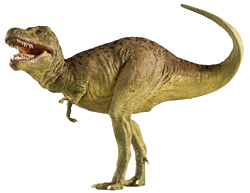DK Science: Hunter Or Scavenger?
Tyrannosaurus was the biggest, fiercest, most formidable hunting animal that ever lived. Or was it? Although it looks like a terrifying predator, and its teeth, jaws, and eyesight seem to confirm that it was, other features such as the muscles and bones suggest that it was a slow mover, unable to run fast after prey. Perhaps Tyrannosaurus used different techniques when it needed to find its food. It may have hunted by running in short spurts and catching slow-moving prey. It may have scavenged on dead animals caught by other, speedier theropods, simply scaring them away as they tried to eat.
This dinosaur was made for meat-eating – just like the other theropods. Its long jaws housed rows of sharp teeth. Its long hind legs were strong. Its body was relatively small, and was balanced by a heavy tail. But it is difficult to tell if the meat Tyrannosaurus ate came from prey that it hunted for itself, or from already dead animals that it found. Its fearsome teeth look like those of a killer, but its sheer size suggests that it was too big and clumsy for hunting.
The sharp teeth of a Tyrannosaurus suggest that it was a hunter. Those at the front are short, thick, and ideal for clamping into struggling prey and stopping it escaping. The long teeth at the side were thinner, more blade-like, finely serrated on both edges, and curved backwards. This made them perfect for slicing off meat that was already dead. All would have been replaced as they broke off or wore out.
The muscles that powered the jaws of Tyrannosaurus were immense. They would have been strong enough to grip a big animal, tear it limb from limb, and crush the bones. Scientists have found Tyrannosaurus tooth marks in the broken bones of horned dinosaurs. The volume of the mouth shows that it could have swallowed up to 227 kg (500 lb) of flesh at a single gulp. Such jaws could have been used by either a hunter or a scavenger.
Tyrannosaurus had eyesight that could have been that of a hunter. The eyes were angled forwards, so the field of view overlapped at the front. This would have given the dinosaur stereoscopic vision – it could have judged distances and seen things in three dimensions as we do. This is a vital ability that a hunting animal needed for targeting its prey. But the overlap is not nearly as marked as that of a modern hunter such as a cat.
The evidence provided by the legs of a Tyrannosaurus have not helped scientists decide whether this animal was a hunter or not. Its leg bones were huge, and perhaps too massive for it to be a fast runner. The amount of muscle also seems to suggest that it was a slow mover because there was simply not enough muscle to allow it to run fast. All this would argue against it being an active hunter. However, the way the bones are jointed suggests that they were designed to be moved quickly. So the evidence found so far is contradictory.
Although we think of hyenas as scavenging animals, they do not always eat animals that are already dead. Hyenas sometimes hunt in packs and bring down swift prey. Likewise, we think of lions as being the ultimate hunting machines. However, lions often scavenge, eating prey that has been killed by another animal. The line between hunting and scavenging is not always clear. Perhaps, back in the Cretaceous, Tyrannosaurus adopted both techniques, hunting when necessary, and scavenging corpses when it found them.
Fast or slow? Predator or scavenger? Either way, Tyrannosaurus was one of the biggest carnivores ever to have stalked the Earth.
| Height: 6.5 m (22 ft) |
| Length: 12.8 m (42 ft) |
| Weight: Up to 6.4 tonnes (up to 7 US tons) |
| Leg length: 2.5 m (8 ft) |
| Stride length: 3.7–4.6 m (2–15 ft) |
| Estimated top speed: 8–72 kph (5–45 mph) |
In nature, a dead animal is a rich source of food. The flesh, internal organs, and even the marrow of the bones are all highly nutritious. Whenever a source of food exists, something will evolve to exploit it. In modern times, dead animals are not left for long – they are soon eaten by scavenging animals. It must have been the same in the Age of Dinosaurs. Living creatures, including Tyrannosaurus and other dinosaurs, would have scavenged the corpses of dead dinosaurs.
To order this book direct from the publisher, visit DK's website.



